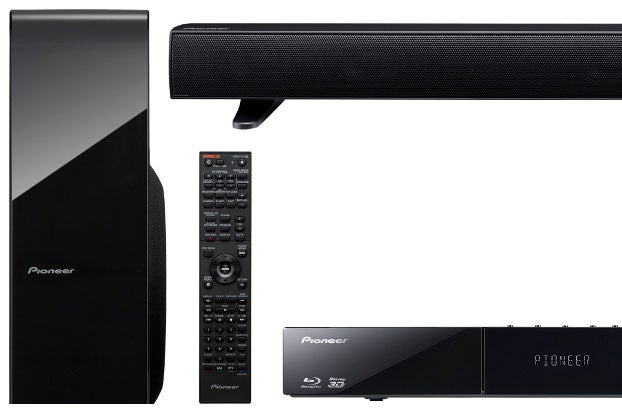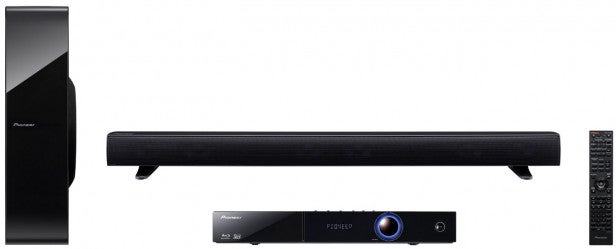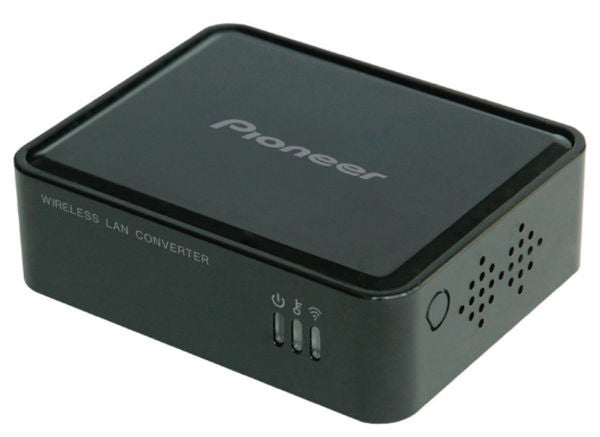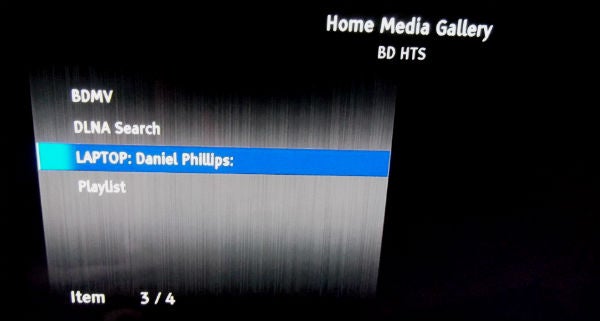Pioneer BCS-SB626 Review
Pioneer BCS-SB626
The Pioneer BCS-SB626A is a discreet 2.1 soundbar system with 3D Blu-ray and DLNA.

Verdict
Pros
- Slim, living room friendly design
- Healthy feature list
- Crisp, dynamic sound
Cons
- Subwoofer could be punchier
- Slightly muffled dialogue
- Limited web content
- Remote
Key Specifications
- Review Price: £349.99
- 550W quoted power output
- 3D Blu-ray playback
- DLNA media streaming
- YouTube & Picasa
- Built-in Wi-Fi
Introduction
The Pioneer BCS-SB626 is a 2.1-channel home cinema system that uses a space-saving soundbar for the front channels, which can be mounted on the wall or placed on top of your TV stand. It’s designed to bring powerful, cinema-like sound into your living room without the clutter and hassle that goes with a regular 5.1 system, providing everything you need in a single box – a combined disc player/AV receiver unit, the soundbar and a subwoofer.
Pioneer BCS-SB626 – Design
The Blu-ray receiver is shaped in the traditional Blu-ray player mould, a straight-edged set-top box with fairly chunky dimensions by today’s standards (430mm wide by 63mm high). It’s not pushing any envelopes design-wise, but it’s attractive nonetheless thanks to its reflective gloss black finish. On the front panel are two flaps, one at each end – the left one hides the disc tray, while the right one conceals two USB ports for media playback and two 3.5mm minijack inputs, one for a microphone and one for portable audio devices. The fascia also houses a large illuminated volume dial, play/pause button and a nicely sized LED display in the middle. Along the top are six tiny buttons for up-close control.

The soundbar – or ‘Sound Wing Bar’ in Pioneer speak – is relatively narrow (800mm) and therefore best suited to 40in TVs. It’s plainly styled in black, with no visible speaker drivers, which are all hidden behind the black mesh, and because all the sockets are housed on the receiver unit there are no connections to worry about – apart from the pre-attached cable that links to the receiver.
Pioneer has sensibly made the subwoofer nice and slim, which makes it easier to slip into tight spaces, but it has to be linked to the receiver using the pre-attached cable, which limits where you can place it – a wireless sub would have been more convenient. It’s also passive, which isn’t ideal if you’re after the very best bass performance, and sounds hollow when you tap the sides. Still, it’s dressed in a fetching gloss black finish with elegantly curved edges, which won’t put your living room to shame.
Pioneer BCS-SB626 – Connections
On the rear panel of the receiver is a healthy line-up of sockets, most notable of which are the HDMI ports. You get one output and two inputs, which allows you to run other equipment (like digital TV receivers and games consoles) through the Pioneer and use it as a switcher (with the Function button on the remote) as well as boosting the sound quality of those devices. The HDMI inputs are v1.4, which means you can play 3D discs on this system, pass through signals from other devices and listen to TV sound using Audio Return Channel.
The HDMIs are joined by two optical digital audio inputs, analogue stereo input, composite video out, an aerial input for the FM tuner and an Ethernet port for accessing the system’s network features. 
There’s also a port that allows you to connect the supplied iPod docking cradle, and another designed for Pioneer’s optional Bluetooth adapter (AS-BT200) for wireless music streaming.
Pioneer BCS-SB626 – Features
So far we’ve ascertained that the BCS-SB626 offers media playback via USB and iPod/iPhone playback, but there are many more strings to its bow. Of course, in a market consumed by smart content and file streaming, the network related features get top billing, which can be accessed using the system’s built-in Wi-Fi connection.
However, the content is less generous than Pioneer’s big name rivals. It offers YouTube and Picasa access, which work smoothly and provide a brief distraction when you’re bored, but without apps like iPlayer and Love Film Pioneer simply can’t compete with the likes of Smart Hub and Viera Connect. The fact that Pioneer’s Blu-ray decks add Netflix merely rubs salt in the wound.
You can, however, stream media files using DLNA protocol, which is hugely convenient if you have hordes of music, videos and photos stored on PCs or NAS drives around the home. Supported formats for streaming include MP3, WMA, WAV, JPEG, DIVX, MP4, 3GP, AAC, WMV, MKV, AVCHD and AVI, while FLAC is supported but only from USB devices and discs.
There were a couple of issues – it wouldn’t play the audio accompanying our WMV files and AVCHD audio was stuttery. But on the whole its media streaming capabilities are impressive, and when you throw SACD playback into the mix, even audiophiles might go away happy. For Blu-ray and DVD playback it decodes a full house of formats, including Dolby True HD, DTS HD Master Audio, Dolby Digital Plus, DTS 96/24 and DTS-ES.
Elsewhere on the spec sheet, Pioneer rates the system’s power output from the Class D amps at 550W, with a rather optimistic-sounding 150W to each front channel (into 4Ω) and 250W for the sub (into 3Ω).
As you’d expect there are several sound modes on board, including Pioneer’s Virtual 3D Sound, available in Min, Mid and Max settings. This aims to expand the soundstage and replicate the feeling of a true surround sound system. Meanwhile, the Sound Retriever function aims to restore dynamics to compressed music formats.
These are joined by a selection of picture tweaks, including Standard, Vivid and Cinema presets, as well as a Custom mode that lets you adjust brightness, saturation, hue, contrast, sharpness and colour transient improvement (CTI). Confusingly, another Video Adjust menu offers separate brightness, contrast, hue and saturation adjustments even when the Custom mode isn’t selected – with two overlapping menus, you could really mess up the pictures, so tread carefully.
Also within the Display setup menu is a Net Contents mode, which is designed to improve the clarity of compressed video files (played via network, USB or disc) plus three stages of Noise Reduction.
You can easily access the Sound Retriever and Virtual 3D Sound settings by pressing the Sound button, and they’re joined by a selection of sound presets – News, Gaming, Movie and Music.
And here’s something you don’t see on many systems these days – a Karaoke mode. So all you budding Christopher Maloneys can murder tunes to your heart’s content after plugging a mic into the front port, plus there are echo control, mic volume and Vocal Cancel settings to fiddle around with.
The final entrant on this impressively long list of features is CD-to-USB recording – a nifty feature if you don’t fancy firing up the PC to rip the new CD you just bought.
Pioneer BCS-SB626 – Operation
Wall mounting the soundbar involves a 6bit of DIY, but tabletop installation is easy – simply screw on the supplied curved feet or attach the adhesive rubber pads.
In action we had no major problems with the system, although the remote is too cluttered, with row after row of identical black buttons and tiny labelling – it took me ages to spot the volume controls. The centrally placed direction pad and surrounding keys are ideally placed but it can’t save the remote from being a confused, cluttered mess. Some streamlining is urgently required for next year.
There’s also a distinct lack of excitement about the onscreen menus – or perhaps we’ve been so spoiled by the exuberant graphics of LG and Samsung’s latest systems that anything else seems dull.
To be fair, Pioneer’s more sober, sophisticated approach is effective, superimposing everything over black backgrounds and spelling out menu options in crisp white text. They’re jazzed up with monochrome images illustrating each menu category.
The layout is easy to follow, although the Web Contents menu isn’t as enticing as it should be. To access DLNA content, select Home Media Gallery from the main menu and all the available devices are displayed in a list, including any detected network servers.
During DLNA music playback, the system streams without any glitches or drop-outs, although there’s a long pause before it starts playing a selected tune. The playback screen shows track details and cover art against a black background, and pleasingly you can browse the menu system while music continues to play.
Sadly you can’t do the same while watching a movie. To make any audio tweaks you have to stop the film and access the setup menu, which is particularly annoying because you don’t know how your adjustments will affect movie playback until you start the film again. There is a built-in test tone, but dedicated level controls on the remote would have been better.
However, the system features a Continued mode, which resumes playback from where you left off – something that you can’t always do with Blu-ray discs.
Pioneer BCS-SB626 – Performance
Disc loading is fast and picture quality is impressive – the 2D Avengers Assemble Blu-ray looks remarkably crisp, with richly saturated colours (check out the blazing reds of Iron Man’s suit) and blacks so solid you can almost touch them. But there’s impressive subtlety in the picture too – from the smoothly shaded contours of Thor’s biceps to the light stubble on Stark’s face. Switch to the 3D Thor disc and the system spoils you with beautifully deep and layered Asgardian landscapes.
In terms of sound quality, the BCS-SB626 ticks most of the boxes. Its stereo soundstage is loud and lively – much more so than any TV’s speakers – putting satisfying force behind effects and producing clean high frequencies. It’s an imposing presence in the room, delivering large-scale action with relish.
The opening scene of Avengers Assemble is a great demonstration of this. Loki’s arrival through the space portal is heralded by a flurry of crisp crackling noises and shooting laser effects that whizz into the room with gorgeous clarity, while the atmospheric score and background effects during the subsequent lull generates a nice sense of tension. And when Loki starts wreaking havoc, gunshots pop and metal objects clank around without making your ears hurt.
There are a couple of foibles, mainly the muddy dialogue reproduction. Certain scenes, like the conversation between Natasha and Banner in chapter 4, are difficult to hear – we had to keep rewinding it to pick up the dialogue, and with no dedicated centre it’s hard to boost the level. Much of the time it’s not an issue, but in general it doesn’t quite live up to the same levels of transparency and clarity as we’ve heard from other soundbars.
The other issue concerns the subwoofer, which lends weight and depth to the sound but not as tightly as we’d like. Out the box it completely overpowered the soundbar, lending a boomy, resonant quality to bass tones. But after trimming the level to -3dB in the setup menu (a level, as we pointed out earlier, reached after a lot of trial and error) it integrated better and stopped drawing undue attention to itself. But even then it didn’t quite offer the punch and agility we crave from a home cinema sub.
The Virtual 3D Sound ‘Max’ setting add a splash of flavour to the stereo soundfield, expanding effects and making everything sound a little fuller. It’s not surround sound by any means, but then we never expected it to be.
Music playback is enjoyable, particularly with SACDs – seduction stalwart Let’s Get It On by Marvin Gaye sounds wonderfully silky through the soundbar.
Pioneer BCS-SB626 – Verdict
With an impressive range of features and a discreet, stylish design the BCS-SB626 is a superb home cinema system that solves a problem for anyone that can’t accommodate a full 5.1 system.
Built-in Wi-Fi, a couple of web apps, DLNA streaming, 3D support, an iPod/iPhone dock, SACD playback and extensive format support make up a terrific feature list, and for around £350 that’s not a bad return. Sure, some buyers might be put off by the limited web content and turn to Samsung or LG, but it’s great to see Pioneer at least doffing its hat to the smart revolution.
In terms of performance, the undisciplined bass and slightly muffled dialogue means it doesn’t quite reach the quality of other soundbar systems from the likes of Yamaha and Harman Kardon, but there’s enough drive, width and detail to ensure an engaging, exciting listen.
Trusted Score
Score in detail
-
Performance 8
-
Features 8
-
Value 8
-
Sound Quality 8
-
Design 8
Features
| 3D Ready | Yes |
| Number of Speakers | 3 |
| Supported Channels | 2.1 |
| DVD Player | Yes |
| Blu-ray player | Yes |
| Audio Processing | Virtual 3D Sound |
| Dolby Digital | Yes |
| DTS | Yes |
| Dolby Pro Logic II | Yes |
| Dolby TrueHD | Yes |
| DTS Master Audio HD | Yes |
Connectors
| HDMI Input | 2 |
| HDMI Output | 1 |
| Microphone | Yes |
| Composite Video In | No |
| Component Video In | No |
| Component Video Out | No |
| S/PDIF Optical In | 2 |
| S/PDIF Coax In | No |
| Subwoofer Out | No |
| Stereo Line In | 1 |
| Stereo Line Out | No |
| iPod Dock | Yes (supplied cradle) |
| Power (Watt) | 550W |
Physical Specifications
| Height (Millimeter) | 63mm |
| Width (Millimeter) | 430mm |
| Depth (Millimeter) | 345mm |
| Weight (Gram) | 3400g |

